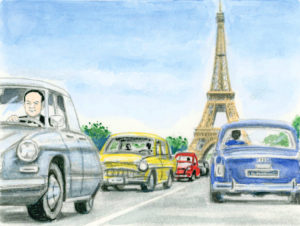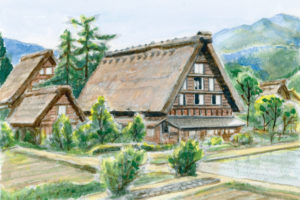This installment, published in the October 16, 2019, issue of the Seikyo Shimbun, focuses on passages from Nichiren Daishonin’s writings that SGI President Ikeda discusses in volume 12 of The New Human Revolution.
Passage 1
“As I have said before, be millions of times more careful than ever.” (“The Hero of the World,” The Writings of Nichiren Daishonin, vol. 1, p. 839)
Be Ever-Vigilant and Strive to Avoid Accidents

Illustration courtesy of Seikyo Press.
In April 1966, Eiji Kawasaki, the central figure of Europe, and his wife, Yoshie, were seriously injured in a car accident.
Accidents are always foreshadowed. Eiji Kawasaki had been involved in an accident once before when he had lost control of his car while driving in the rain, hit a boulder and overturned. There had been no casualties, but the car had been totaled.
While visiting Japan shortly after his first accident, Eiji reported the incident to Shin’ichi Yamamoto, who said: “You should take this as a warning of an even more serious accident. Leaders need to be ever vigilant, perceiving an accident as a warning and taking appropriate measures to ensure it doesn’t happen again. By doing so, critical situations can be avoided.
“From now on, I hope you will chant earnestly with the determination never to have another accident, and that you will drive safely, observing all the rules of the road. Moreover, as exhaustion or lack of sleep can be a major cause of accidents, it’s important to make sure to drive only in the best physical condition. That is the duty of a driver.”
■ ■ ■
“It’s also important that you don’t become so engrossed in conversation with a passenger that you are distracted from what you are doing. Leaders should not only take these precautions themselves, but also remind members to drive home safely after meetings or other activities. This simple gesture will put everyone on alert and help prevent accidents.” (The New Human Revolution, vol. 12, pp. 41–43)
Passage 2
“Now the place where Nichiren and his followers chant Nam-myoho-renge-kyo, ‘whether … in mountain valleys or the wide wilderness’ (chapter twenty-one, Supernatural Powers), these places are all the Land of Eternally Tranquil Light.” (The Record of the Orally Transmitted Teachings, p. 192)
Community Revival Is Born of the Love People Feel for Their Hometown

Illustration courtesy of Seikyo Press.
In August 1967, Shin’ichi Yamamoto visited Wakayama City in Gifu Prefecture. The members there chanted for the development of their home- town, devoting themselves to developing their local community.
Community development and revitalization are important issues anywhere, but they can be a matter of survival in underpopulated villages and mountainous regions. If, however, people lose faith in their community and give up hope, there can be no prosperity.
Community revival is born of the love people feel toward their hometown; it is inspired by each person’s awareness that he or she is a protagonist in that endeavor. In other words, the key to revitalizing a community is to revitalize the hearts of those who reside in it.
■ ■ ■
Wherever we are actively carrying out our Buddhist practice is the Land of Eternally Tranquil Light where the Buddha dwells.
That is why Soka Gakkai members, instead of searching for an ideal realm or happiness somewhere apart from reality, have lived out their lives with the conviction that the place where they are is essentially a treasured land. They have made it their personal philosophy and mission in life to transform that place into an ideal realm where they can raise the banners of happiness and victory, no matter what difficulties or hardships they face.
Realizing the prosperity of a community or region begins with transforming the mind-sets of the people who live there and cultivating the earth of the human spirit. It is in such effort that a strong sense of community spirit is fostered, resulting in the growth of luxuriant trees of progress, the blossoming of beautiful flowers of wisdom and the development of a fertile plain of happiness. This is the purpose of the Soka movement. (NHR-12, 170–71)
The First Collection of Dialogues
The “Dance of Life” chapter in The New Human Revolution, volume 12, describes the dialogue between President Ikeda and Count Richard Coudenhove-Kalergi.
When the Count was 28 years old, he published Pan Europe, a book calling for the unification of Europe. During World War II, the Count had suffered persecution by the Nazis and was forced into exile. But he continued to make efforts to realize the unification of Europe.
In 1967, the same year Shin’ichi and the Count had their dialogue, the European Council (presently known as the European Union) was established.
During their dialogue, the Count called Soka Gakkai’s activities “a revival of Buddhism … the world’s first fraternal movement” (NHR-12, 240). He also offered words of praise, saying, “I regard the revival of Buddhism in Japan by the Soka Gakkai as Japan’s response to the materialism that dominates our world, and I think this marks the beginning of a new age in the history of religion” (NHR-12, 247).
Even after their dialogue, the exchange between the two continued through written correspondences.
In October 1970, they met again and held talks for more than 10 hours, meeting in locations such as the Seikyo Shimbun building, as well as Soka Junior High and Soka High School’s campus on the third anniversary of the schools’ opening. They spoke about diverse topics, including world affairs and perspectives on youth. A few years later, their dialogue was published in Japanese under the title Civilization: West and East.
As of today, SGI President Ikeda has had dialogues with over 80 of the world’s foremost thinkers. The dialogue with Count Coudenhove-Kalergi was the first of such discussions.
You are reading {{ meterCount }} of {{ meterMax }} free premium articles

